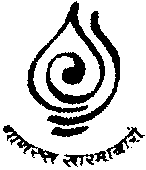
Bhagvan Mahavir established the existence of five fundamental substances (astikayas).
In the outskirts of Rajgir was a garden named Gunashalik. Just a few yards away from that was a hermitage of wanderers (parivrajaks). Once when Bhagvan Mahavir came to stay in Rajgir, he stayed at Gunashalik. There used to be a lay follower of Mahavira called Madduk in Rajgir. Once when he was coming back after paying his obeissance to Lord Mahavira the parivrajaks stopped him and said, "Your religious preceptor, Shraman Mahavir expounds the philosophy of five fundamental substances, do you know them, have you seen them?"
Madduk replied, "I see what is functional; what is not functional I do not see, I do not know about."
The parivrajaks said „What kind of a follower are you, you do not know and do not see the fundamental substances as established by your own religious preceptor?"
Hearing the challenge in their voice, Madduk said, "Gentlemen! Is the wind blowing?"
"Yes it is."
"Are you seeing the form of the blowing wind?"
"No."
"Gentlemen -we do not see the wind, but do we not discern from the moving leaves that the wind is blowing? The fragrance of flowers is wafting in the air?"
"Yes it is."
"The atoms of fragrance are entering our nostrils?"
"Yes they are."
"Are you able to see the atoms entering your nostrils?"
"No."
"Gentlemen is there fire in firewood?"
"Yes there is."
"Are you able to see it hidden in the wood?"
"No."
"Gentlemen neither you, nor I, nor any person who is equipped only with indirect perception can know or see the object which is subtle, concealed by partition or existing at a very far distance. But to say that they do not exist is not true. The incompleteness of our knowledge cannot wipe away the existence of the substance. If I am not seeing or knowing all the five fundamental substances, it does negate their existence. Bhagvan Mahavira through his intuitive power has seen and known them and so established them."
From this it is evident that the idea of five fundamental substances was one of ridicule for other philosophers. They did not know about it, nor had they heard or read about it. This was totally new to them and Madduk's logical explanation also did not convince them.
A few days later, the parivrajaks gathered again in an assembly. In that gathering, Kalodayi, Shailodayi, Shaivalodayi and others were present. Kalodayi asked, "Shraman Mahavir establishes the existence of five fundamental substances: dharmaastikay, adharmaastikay, Akashastikay, jivastikay and pudgalastikay. He says that four of them are insentient and one is sentient. Four of them are imperceptible and only the pudgal astikay is perceptible. How can that be?" At that time a senior disciple of Mahavir, Gautam was going towards Gunashalik. The parivrajaks looked at Gautam and said, "Look, there goes Gautam. Who can represent Mahavir better? Let us go to him and ask our questions.' In those days ascetics used to meet, invite the other over and have free discussions of this nature. There was freedom to think and freedom of speech. So the parivrajaks did not have any problem going to Gautam. They went to him and asked, "Your religious leader has established the existence of five fundamental substances, are they valid?"
Gautam replied, "Long live my friends, we do not deny existence and affirm the non-existent. All that exists we say exists and all that does not exist we say does not exist. You yourself think about this and reflect upon it."
Having given this brief reply, Gautam went ahead. Kalodayi thought they had asked Madduk and Gautam about the five astikayas who answered in their respective manner. But when Mahavir himself is here, why not ask him? He turned and went that way. At that time Mahavir was delivering a lecture when he saw Kalodayi. "Kalodayi! You people were having a discussion during which you were debating on the five fundamental substances, astikayas, as given by me?" "Yes Lord! It was just like that." "Kalodayi, your question is that how do I propound the theory of five astikayas. Tell me do you believe in five basic substances? To whom is this question addressed? To the sentient or the non-sentient? To the soul or non soul?" "My Lord it is addressed to the soul." "Kalodayi, that which you call the soul I call jivastikaya. Soul is an indivisible texture of units of consciousness (pardesh), so I call it the jivastikaya. Kalodayi, do you know that a fish swims in water?" "Yes Lord I do."
"Is the energy to swim found in the fish or in water?"
"It is in the fish Lord."
"Then can it swim without water?"
"No Lord! That cannot happen."
"Just as the fish needs water to swim, the soul and matter need a substance which can assist in their motion. That substance which assists in their motion I term as dharmastikaya. The fish on coming out of water becomes motionless. The fish has the capacity to be motionless but the earth also supports that state. The soul and matter also have the capacity to be motionless. That which helps them retain that state is what I call adharmastikaya. Medium of motion and rest are both astikayas. Extension of their pardesh spreads over a part of infinite space. The portion of the cosmos where there is motion, vibration, life and transformation. I term this cosmic space as lok. That, which is beyond this cosmic space, I call alok. The part of the cosmos within the lok is finite, having a boundary. The rest of alok is infinite, without a boundary. You are seeing that this tree, man and house are lodged somewhere. You have seen that water rests in a pot. If the pot breaks, water spills. Water needs some base in which to rest. Similarly substance too needs a base. The substance which is in existence and able to form a base, I call akashastikay."
"You see that there is a tree before us. Are you seeing it? Is its perfume not wafting?"
"Yes Lord."
"Do its tender leaves not enchant the mind."
"Kalodayi! That which has colour, taste, smell and touch I call pudgalastikaya."
"I have known and seen astikayas. That is why I have established five realities."
The soulful lecture of Mahavira appeased Kalodayi. This division of five fundamental substances is basic. With a background of the metaphysical classifications of different schools of Indian philosophy no one can say that this categorization is borrowed. Some scholars after inadequate research make such claims and keep furthering them. It is a matter of serious reflection that such incomplete interpretations are gaining ground.
 Acharya Mahaprajna
Acharya Mahaprajna


